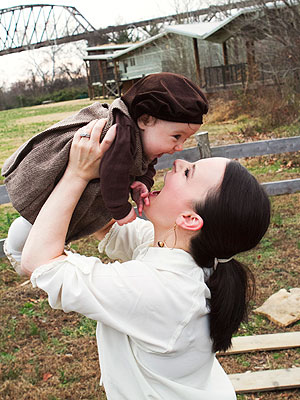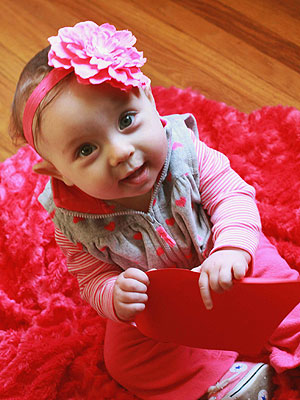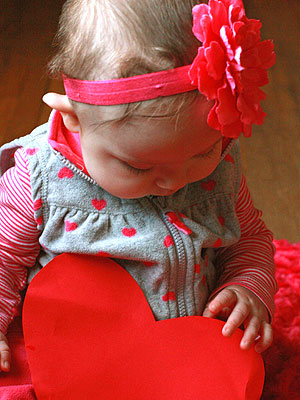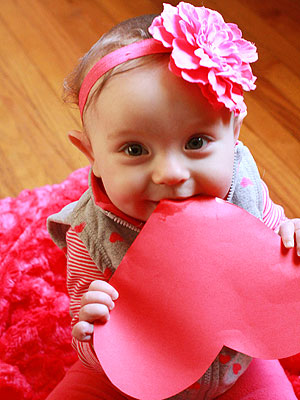
One of my valentines – Lila McCann Photography
Celebrity blogger Jenna von Oy is a new mama!
Best known for her roles as Six on Blossom and Stevie on The Parkers, von Oy is also a musician who has released two albums and is set to publish a book, The Betweeners.
von Oy, 35, wed Brad Bratcher on Oct. 10, 2010, and resides in Nashville with her husband and five dogs.
They welcomed their first child, daughter Gray Audrey, on May 21. She is now 8 months old.
In her latest blog, von Oy reflects on the memorable events and observations that have made her realize what loving a child truly is.
You can find her on Facebook and Twitter @JennavonOy, as well as posting on her weekly blog, The Cradle Chronicles.
Author’s Note: This month’s post officially marks my one-year anniversary of blogging for PEOPLE.com. I have loved — and continue to love — every moment of sharing the motherhood experience with all of you. Thank you for being a part of this adventure with me! Here’s to many more … — Jenna
I know a plethora of folks out there regard Valentine’s Day as a meaningless “holiday.” There are those who feel it is an overrated day of commercial benefit, perpetuated by greeting card companies and chocolate manufacturers, and I suppose they may not be entirely off-base.
After all, do we need a calendar to tell us when to give flowers, or candy, or paper hearts? Is it necessary to oversaturate the market with tangible items meant to represent something completely intangible?
While I respect those who stand staunchly by that viewpoint, I prefer not to be quite so cynical about the whole deal. Instead, I choose to see the day as a not-so-gentle nudge in the right direction for those who aren’t as romantically inclined by nature. I believe that romance is a learned habit and doesn’t come easily for everyone out there.
I realize, for instance, that in asking some men to sit down for a candlelit dinner, you might as well be asking if you can inflict them with the bubonic plague. I suspect Feb. 14th incites a perpetual “deer in the headlights” look from spouses across America, as they tear their hair out over finding a token keepsake that says, “I love you” with just the right amount of pizzazz.
The thought of coming up with gift ideas makes many a husband break out in a massive case of hives, God bless them.
But there are gifts that can’t be wrapped and sentiments that a Hallmark card can’t write for us. They generally come in the form of unconditional love, support, affection and intimate moments shared while the kids are asleep. And, in my book, they are the most treasured gifts one can give or receive.
All of the silly lollipops and forget-me-nots aside, I think Valentine’s Day is a good time to articulate our appreciation. It’s an opportunity to reflect on the little things that endear us to one another, that made us fall in love to begin with. Which brings me to…

Happy – Courtesy Jenna von Oy
I certainly don’t want to diminish the feelings any of us have for our significant others, but I believe Valentine’s Day is about love in all capacities, rather than just a romantic one. On May 21st of 2012, when my daughter was born, my husband and I fell in love all over again — with our baby girl, as well as with each other.
We are celebrating our parental love this Valentine’s Day too, because its depth has propelled us into an entirely different stratosphere. The feelings we have for Gray are limitless, overwhelming and instinctual. Though our love for her is unquantifiable, it is somewhat measured by the small moments that resonate in a big way.
Those instances have taken many forms; they’ve been hilarious, gut-wrenching, terrifying, wonderful, smile-worthy, tear-inducing and poignant … sometimes all at once!
So, in honor of the first Valentine’s Day we get to be in love as a family, I have compiled a list of some of the memorable events and observations that have made us realize what loving a child truly is. It is by no means comprehensive (we’ve only been parents for eight months, after all), but it’s a start!
Since laughter is a form of sharing love, I’ve stuck to mostly tongue-in-cheek examples. Hopefully you’ll giggle along with us as you reminisce about some of your own love-inspiring anecdotes.
A big hug of thanks to my mom, who contributed some of her experiences as well. Please feel free to leave your own additions in the comment section that follows!

Valentine’s – Courtesy Jenna von Oy
Love Is…
1. Slobbery baby kisses.
2. Knowing you’d go through another nine months of praying to the porcelain god, puffing up like a French pastry, breaking out in acne and mysterious rashes, suffering through back pain, craving pickles and ice cream, (insert your own personal hell here…) and feeling like you’ve been lifting weights from your breasts, if it meant having another child who’s as perfect as the one in your arms.
3. Inviting in the dawn of a new media decade — a.k.a. forgoing your favorite car playlist to listen to Winnie the Pooh music, and swapping out that episode of Scandal you Tivo’d in exchange for back-to-back episodes of Yo Gabba Gabba.
4. Becoming best friends with the unholy trinity — poop, puke and snot.
5. Having the covers stolen, freezing your butt off all night, then somehow winding up in the co-sleeper because your child is a nighttime nomad.
6. Trading in your party dress and stilettos for practical shoes and clothes that don’t purport to be “dry clean only.”
7. Knowing the words to every Disney song better than your child does. (Are there bonus points for dressing up like the princess who sings them?)
8. Learning that Play-Doh is not easily removed from carpets, and walls are not an ideal medium for crayon drawings.
9. Bundling your child in so much winter paraphernalia that they resemble the Michelin Man, but forgetting to put your own coat on.
10. Loving and admiring your spouse even more, because he or she is such a phenomenal parent.
11. Gladly trading in wine night with the girls to read Goodnight Moon for the hundredth time.
12. Allowing yourself to become a human jungle gym … and scratching post … and teething toy.
13. Treasuring the fact that your child is still asleep in your arms, even though your arms have gone to sleep too.
14. Praying the good in the world outweighs the bad, and your child’s innocence lasts longer than a marshmallow Peep in your pantry.
15. Saving for your child’s college fund, instead of getting a new fall wardrobe.
16. Accepting that your nipples have become a part-time taffy pull, and it’s worth it for the incredible bonding of breastfeeding. (As a side note, this is nothing against those of you who don’t breastfeed … I support you either way!)
17. Discovering that your idea of a Friday night out on the town now entails root beer, Tater Tots and tickets to Sesame Street on Ice.
18. Being overly excited about the prospect of potty training.
19. Finding redeeming qualities during the terrible twos. And the terrible threes. And…
20. Making up annoying ditties about everything from changing stinky diapers to taking naps, just to see your kid smile.
21. Discovering that sleep is a privilege. After all, you might be getting less than you did in college, but the rewards are 10 times greater than passing your exams.
22. Going to Disneyland and enduring endless rotations of “It’s a Small World.”
23. Knowing that you will never have your own ice cream cone again.
24. Crying along with your child when they get hurt for the first time.
25. Giving up your attachment to anything breakable, discovering that your plants are much shorter than they used be, and accepting that your home now serves as one giant toy box.
26. Sporting spit up on your blouse, and hoping it becomes en vogue on the fashion runways this year. What, you’re saying vomit isn’t the new black?
27. Scaring away imaginary monsters under the bed, knowing there are real ones out there in the world, and doing your best to protect your child from all of them.
28. Being excited to go to sleep at night so you can cuddle together; being excited to wake up in the morning so you can laugh together.
29. Making seven loops around the mall at Christmastime, just to find the beloved giraffe pacifier that mysteriously disappeared from the stroller.
30. Knowing you’ll never be on time again (or in my mom’s case, appreciating that you now have an excuse for why you aren’t…)
31. Acknowledging that drool has replaced Aqua Net as your favorite hair product, and your locks double as an “oh #@$&” handle for your infant.
32. Dragging three kids on a train ride to New York, and realizing you’ll never be the same afterwards … For that matter, neither will the passengers who sat anywhere near you. (God bless you for braving that, Mom!)
33. Packing half the nursery for a road trip: changes of clothing, diapers, wipes, teethers, books, a sippy cup and everything else you can think of, only to realize you’re driving in your slippers.
34. Thinking it’s cute when your baby burps loudly during a church service.
35. Noticing an hour has gone by, and all you’ve accomplished is gazing intently at your sleeping child.
36. Crying at the end of The Velveteen Rabbit, because you finally understand what “being real” is.
37. Loving every second of the experiences listed above, and realizing they don’t mean that you’ve lost sight of who you are … they mean you’ve found the best parts of you.

Day! – Courtesy Jenna von Oy
Wishing you a Valentine’s Day filled with love … no matter what form it takes.
Until next time,
– Jenna von Oy
More from Jenna’s PEOPLE.com blog series:













